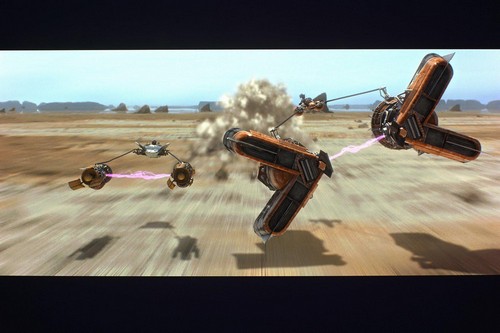 Photo by: reeladvice.net
Photo by: reeladvice.net
Thirteen years after its original release, George Lucas adds another (third) dimension to “Star Wars Episode I: The Phantom Menace.”
The film is the first of the Star Wars prequels, developed after the classic original trilogy. In it, Lucas tells the tale of Jedis Qui-Gon Jinn (Liam Neeson) and Obi-Wan Kenobi (Ewan McGregor) protecting Queen Amidala (Natalie Portman) and accidentally discovering Anakin Skywalker (Jake Lloyd), the future Darth Vader.
At the time of its original release, the film received varying degrees of criticism from critics throughout the community. Some critics considered the film superb, while another group – if not larger, certainly more vocal – felt disappointed after the original trilogy and had particular qualms with the character Jar Jar Binks (Ahmed Best).
Reviews, both positive and negative, still hold for the movie, but re-releasing the film appears to be an attempt to reach a new generation of viewers as well as bring new light to the world Lucas created. The overall effect, however, is a mixed bag.
Two aspects of the film truly shine with the addition of 3D to the film: the landscape and, more specifically, the pod-racing scene.
The first of these is especially apparent whenever the film uses an establishing shot for the environment, building or general area where a scene will take place. Locations such as the underwater Gungan city, Otoh Gunga, the palace at Naboo and the capital planet Coruscant are visually stunning in 3D and truly breathe life into the imaginative universe.
Fans who are familiar with the film will remember the pod-racing scene, where Anakin participates alongside aliens in a high-stakes and highly dangerous spacecraft race, which he wins, thus earning his freedom. This scene stands out in particular as a great example of how 3D can be used effectively. Between the added visual depth, the flying rocks and the multitude of camera angles, this is a scene new and old fans alike will enjoy.
Despite these good aspects of the re-release, there are significant shortcomings as well. Though the 3D medium brings the larger setting alive, viewers will be left wanting more with the immediate environment and the characters, who stay almost entirely within their 2D constraints.
In the film’s fight scenes, be they Jedi skirmishes or the big-scale battle between the Gungans and the Trade Federation’s droids, the third-dimension remains elusive and viewers will have difficulty finding many differences between the 1999 release and its 3D counterpart.
The 3D experience adds little to the exposition of the film, either. The allure from the addition of the third dimension, though it excels in certain action settings, tends to fall flat when the characters interact through dialogue and “The Phantom Menace” is no exception. This fact is not helped when much of the film takes place on the monochromatic desert planet of Tatooine.
When comparing the 3D experience of “The Phantom Menace” to that of one such as James Cameron’s “Avatar,” they appear to be on entirely different levels of engaging the viewers and bringing their respective fantastic worlds to life. Perhaps this is attributable to the simple fact that “The Phantom Menace” was not originally shot for a 3D release.
Regardless of this, fans of the movie will enjoy seeing what the added dimension has given the film, but those who did not enjoy the film the first time around should think twice before they give it a second try.











